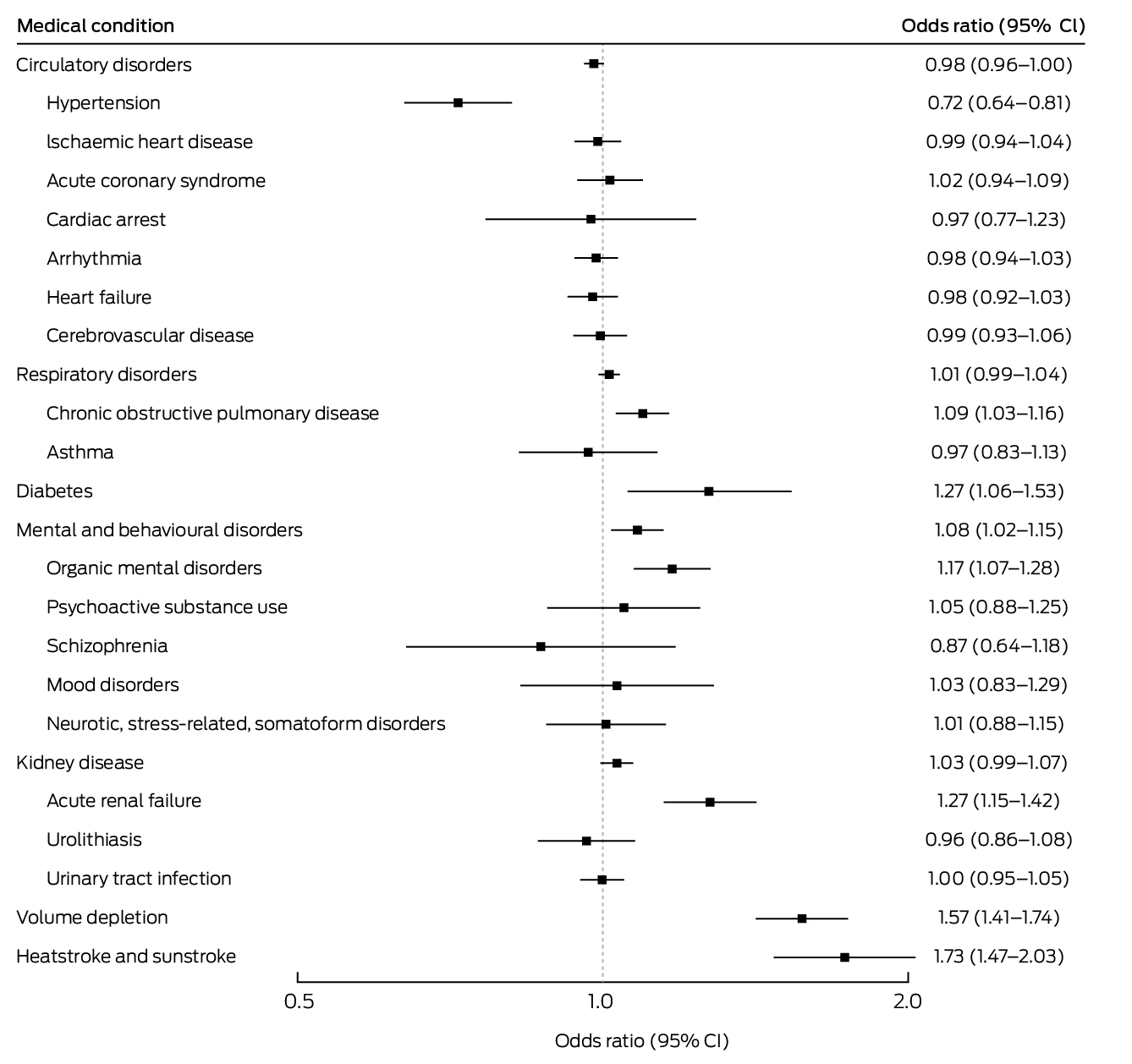High temperatures and extreme heat events are associated with morbidity and mortality; very young and very old people and those with certain medical conditions are at particular risk.1,2 It is anticipated that the health effects of heat will grow as climate change increases the incidence, magnitude, and duration of extreme heat events.1 In Victoria, the annual number of very hot days could be twice the 1986–2005 mean by the 2050s if the current rate of global warming continues.3
The health effects of extreme heat have been extensively described, but published data that could inform estimates of its impact in Victoria are limited. Jurisdiction‐specific data are crucial because regional differences in acclimatisation, adaptation responses, and population susceptibility preclude the simple extrapolation of risk estimates from one area to another.4
During 2010–22, the Victorian Department of Health issued local heat health alerts during summer when the temperature forecast met or exceeded pre‐defined thresholds (Supporting Information, section 1). We have analysed associations between these alerts and cause‐specific public hospital emergency department presentations by people aged 65 years or older. We analysed Victorian Department of Health public hospital emergency department data (Victorian Emergency Minimum Dataset; VEMD) for 1 November 2010 – 31 March 2022 in a space–time‐stratified case–crossover study design; that is, each participant acts as their own control, eliminating the need to account for time‐invariant confounders.5 Case periods were defined as the day of and the day after a heat health alert, to account for lagged effects, and were matched to control periods (all days with the same day of the week, month, and year, if these days were not already included as case days). We used conditional logistic regression to compare emergency department presentations by people aged 65 years or older during the case and control periods for a set of International Classification of Diseases, tenth revision (ICD‐10) codes selected a priori following a review of the published literature. Analyses were undertaken in R 4.1.2, using the clogit function in the survival package;6 we report odds ratios (ORs) with 95% confidence intervals (CIs) (further details: Supporting Information, part 2). The Australian National University Human Research Ethics Committee approved our study (2022/374), and we report it in accordance with the STROBE statement.7
The Victorian Department of Health issued 369 heat health alerts during November 2010 – March 2022, yielding 572 weather district‐specific case and 1521 control days. The odds of people aged 65 years or older presenting to emergency departments with volume depletion (OR, 1.57; 95% CI, 1.41–1.74) or heat‐ or sunstroke (OR, 1.73; 95% CI, 1.47–2.03) were higher on case than control days. The odds of presenting with hypertensive disease were lower on case days (OR, 0.72; 95% CI, 0.64–0.81), while the odds of presenting with chronic obstructive pulmonary disease (OR, 1.09; 95% CI, 1.03–1.16), diabetes‐related conditions (OR, 1.27; 95% CI, 1.06–1.53), organic mental disorders (OR, 1.17; 95% CI, 1.07–1.28), or acute renal failure (OR, 1.27; 95% CI, 1.15–1.42) were higher (Box).
Our findings suggest that extreme heat influences the risk of morbidity for several organ systems in older Victorians beyond the conditions typically associated with heat exposure, such as heatstroke. This conclusion is consistent with those of earlier reports,2,8 underscoring the importance of heatwave forecasting and warning systems, proactive advice for population groups at particular risk and their carers, and health service preparedness for increasing demands on emergency departments related to heat.9
Differences between our findings and those of similar studies — for example, the cardiovascular disease risk associated with heat exposure2 — could be related to population‐specific factors, differences in heat exposure definitions, or inadequate statistical power in our study to detect small differences in risk. Further, we assessed associations between health outcomes and health alerts, rather than meteorological data. Other limitations of our study include the inability to control for time‐varying confounding factors, such as air pollution, because the relevant data were not available; our not including private hospital emergency department data; uncertainty regarding the appropriateness of the exposure window selected to accurately take delayed effects of heat into account;5 our inability to adjust for auto‐correlation of data; and the possible misclassification of outcomes by ICD‐10 code in VEMD data.10 Finally, our findings may also not be generalisable to other parts of Australia, given the specific alert system and the restriction of our study to Victorian residents.
During the 2022–23 summer, the Victorian Department of Health aligned its heat health alerts with the Australian Bureau of Meteorology heatwave warning system (Supporting Information, section 1). Further analyses applying the new exposure definition will be crucial for informing public health responses to heat in Victoria.
Box – Cause‐specific emergency department presentations by people aged 65 years or older in Victoria, 1 November 2010 – 31 March 2022: case (heat health alert) v control periods*

* The International Classification of Disease, revision 10 codes used to identify medical conditions in the Victorian Emergency Minimum Dataset are included in the Supporting Information, part 3, as are the numbers of cases of each condition during the case and control periods.
Received 29 June 2023, accepted 6 February 2024






Open access:
Open access publishing facilitated by Australian National University, as part of the Wiley ‐ Australian National University agreement via the Council of Australian University Librarians.
Data sharing:
Requests for data from the Victorian Emergency Minimum Dataset can be made to the Victorian Agency for Health Information (https://vahi.vic.gov.au). Victorian heat health alerts data are available online (see Supporting Information).
Tilda Thomson is a Master of Philosophy in Applied Epidemiology Scholar at the Australian National University, supported by a Master of Philosophy in Applied Epidemiology Scholarship funded by the Victorian Department of Health.
No relevant disclosures.